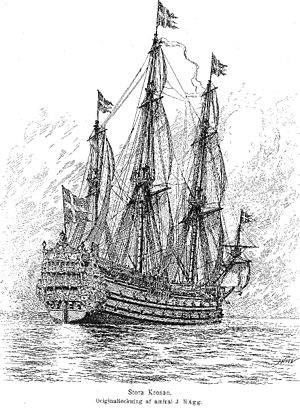Kronan (ship)

Reconstruction by Jacob Hägg, 1909
|
|
| History | |
|---|---|
|
|
|
| Name: | Kronan |
| Namesake: | Royal crown of Sweden |
| Builder: | Francis Sheldon, Stockholm |
| Laid down: | October 1665 |
| Launched: | 31 July 1668 |
| Commissioned: | 1672 |
| Fate: | Sunk at the Battle of Öland, 1 June 1676 |
| General characteristics | |
| Type: | Ship of the line |
| Displacement: | 2,300 tonnes (approximate) |
| Length: | 53 m (174 ft) |
| Beam: | 12.9 m (42 ft) |
| Height: | 66 m (217 ft, keel to mast) |
| Draft: | 6.2–6.8 m (20–22 ft) |
| Sail plan: | ship rig |
| Troops: | 300 soldiers |
| Complement: | 500 sailors |
| Armament: |
|
Kronan, also called Stora Kronan, was a Swedish warship that served as the flagship of the Swedish navy in the Baltic Sea in the 1670s. When built, she was one of the largest seagoing vessels in the world. The construction of Kronan lasted from 1668 to 1672 and was delayed by difficulties with financing and conflicts between the shipwright Francis Sheldon and the Swedish admiralty. After four years of service, the ship foundered in rough weather at the Battle of Öland on 1 June 1676: while making a sharp turn under too much sail she capsized, and the gunpowder magazine ignited and blew off most of the bow. Kronan sank quickly, taking about 800 men and more than 100 guns with her, along with valuable military equipment, weapons, personal items, and large quantities of silver and gold coins.
The loss of Kronan was a hard blow for Sweden during the Scanian War. Besides being the largest and most heavily armed ship in the Swedish navy, she had been an important status symbol for the monarchy of the young Charles XI. Along with Kronan, the navy lost a sizeable proportion of its best manpower, acting supreme commander Lorentz Creutz, numerous high-ranking fleet officers, and the chief of the navy medical staff. A commission was set up to investigate whether any individuals could be held responsible for the Swedish fiasco at the Battle of Öland and other major defeats during the war. Although no one was officially held accountable, Creutz has been blamed by many historians for the sinking of Kronan because of his naval and command inexperience. Recent research has provided a more nuanced picture, and points to Sweden's general lack of a well-developed naval organization and officer corps at the time.
Most of the guns that sank with Kronan were salvaged in the 1680s, but eventually the wreck fell into obscurity. Its exact position was rediscovered in 1980 by the amateur researcher Anders Franzén, who had also located the 17th-century warship Vasa in the 1950s. Yearly diving operations have since surveyed and excavated the wreck site and salvaged artifacts, and Kronan has become the most widely publicized shipwreck in the Baltic after Vasa. More than 30,000 artifacts have been recovered, and many have been conserved and put on permanent public display at the Kalmar County Museum in Kalmar. The museum is responsible for the maritime archaeological operations and the permanent exhibitions on Kronan.
...
Wikipedia
